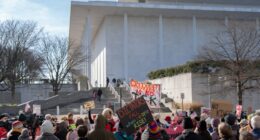Share this @internewscast.com
Topline
Many Americans are feeling increasingly uncertain about their future financial prospects, with concerns about job security, housing affordability, and retirement savings on the rise. This sentiment was revealed in a recent poll conducted by AP-NORC in October, highlighting widespread economic anxiety.
The poll, released on Sunday, indicates a slight dip in overall economic optimism over the past two months. Currently, only 32% of Americans maintain a positive outlook on the economy, reflecting a growing sense of unease.
While 59% of participants described their financial situation as stable, a mere 12% felt they were making progress. This suggests that a significant portion of the population is struggling to improve their financial standing.
When it comes to job security, nearly half of the respondents, 47%, expressed little to no confidence in their ability to secure a good job if necessary. In contrast, 30% reported feeling somewhat confident, while just 21% were very confident in their job prospects.
The poll also highlighted that grocery prices are a primary source of stress for many, affecting 65% of adults earning under $50,000 annually. This concern decreases slightly among higher income brackets, with 52% of those earning between $50,000 and $100,000, and 42% of those earning above $100,000 feeling the pressure.
Housing expenses emerged as the second most significant stressor, with 45% of Americans across various income levels identifying it as a major concern.
Housing costs were the second biggest stressor, according to the poll, with 45% of Americans across income levels reporting it as a “major source” of stress.
How Are Lower Income Americans Feeling About The Economy?
A majority of Americans polled said they were holding steady despite the economic outlook, but these results differed greatly when broken down by income. Forty-three percent of Americans who make less than $50,000 said they were falling behind, compared to only 23% in the middle bracket and 16% in the highest bracket. Americans in the lowest bracket surveyed also expressed skepticism that they could afford major purchases—68% said they had little or no confidence they could afford emergency medical expenses, 76% expressed little confidence in their ability to buy a new home and 69% had little confidence in the amount they saved for retirement. Americans in this bracket also expressed the most doubt about their ability to find a good job, with a 60% majority having no or little confidence in their ability to find one if needed. Electricity costs are also beginning to stress lower income Americans, according to the poll results, with 48% labeling these costs as a “major source” of stress and 36% as a “minor source.”
How Does The Polling Break Down Along Party Lines?
Republicans were more likely to feel confident about the economy during President Donald Trump’s second term, with 58% still expressing optimism. This result was down slightly from the last AP-NORC poll taken in August, which found 63% of Republicans feeling optimistic. Democrats were much more pessimistic, with only 14% viewing the economy positively, while an 86% majority viewed the economy negatively. About 83% of independents also viewed the economy negatively, according to the results. The polling also broke down along age lines. Forty-one percent of adults over age 60 viewed the economy positively, while only 17% of those surveyed under age 30 had a positive outlook.





